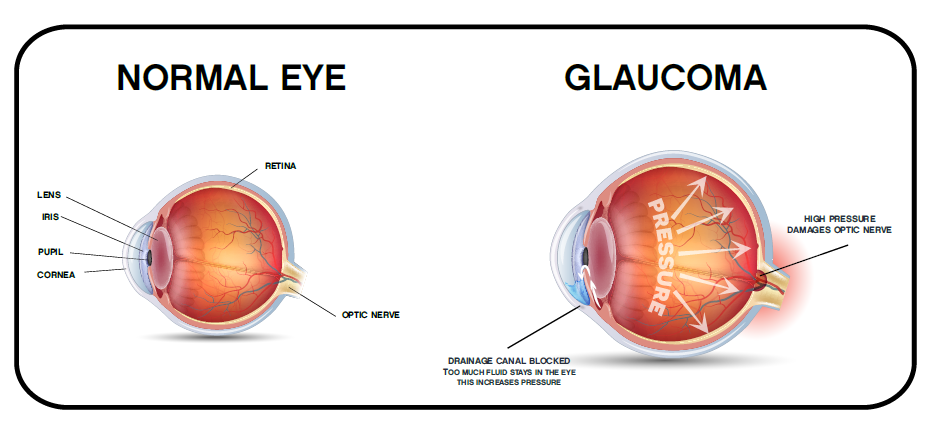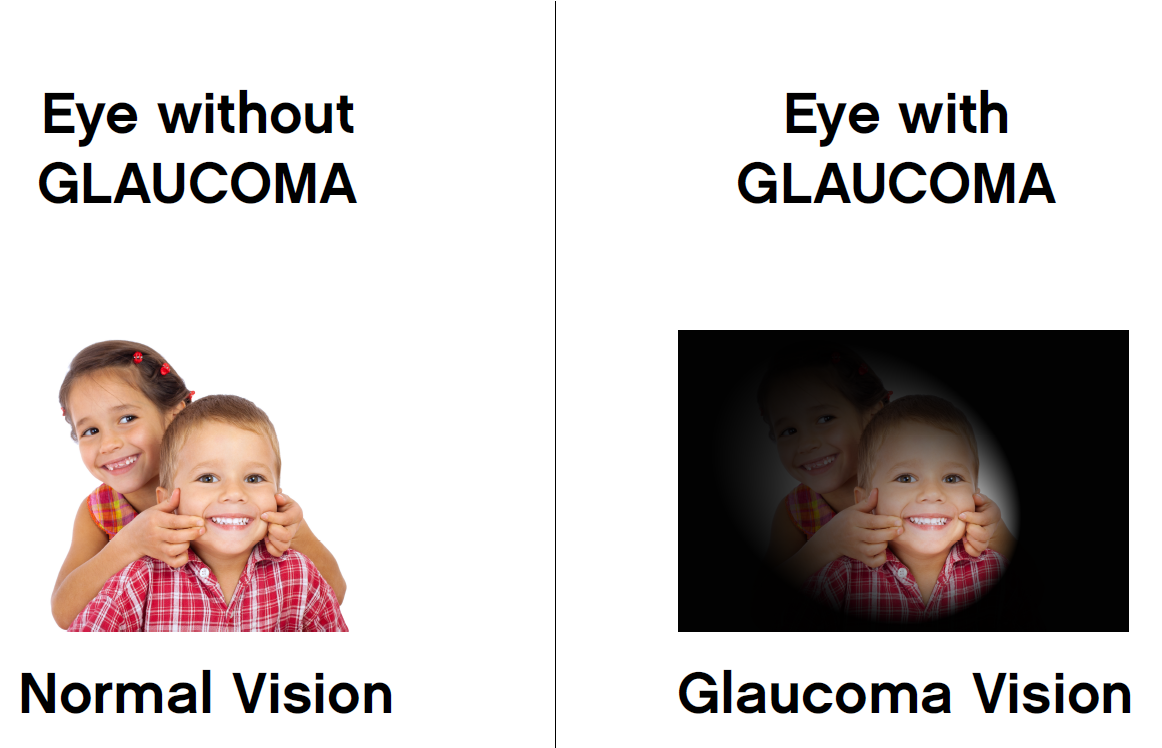- A-
- A+

GLAUCOMa and preservative-FREE TREATMENTS
Glaucoma is a common eye disorder. Different treatment options are offered, tailored to glaucoma type and seriousness. Some local treatments (eye drops) are preservative-free.

Glaucoma damages the optic nerve, and this causes alterations of the visual field. This eye condition ranks third in causes of blindness around the world, after cataract and AMD (Age-related Macular Degeneration).
WHAT IS GLAUCOMA?
Glaucoma is an eye disease that is characterized by loss of nerve tissue that results in vision loss. destroys the optic nerve. This nerve at the back of the eye (retina) transmits images to the brain.
Glaucoma causes irreversible damage to cells in the optic nerve. It only affects peripheral vision at first, but if left untreated, this disease will ultimately compromises the entire visual field.
diffErents types OF glaucomA
There are several types of glaucoma:
- Primary open-angle glaucoma: this is the most commonly form of the disease (90% of cases). It is caused by blockage of the drainage channels in the eye, preventing aqueous humour from draining. Most often, it only becomes evident after it has been progressing for several years. It generally affects both eyes.
- Acute angle-closure glaucoma: it is rarer and may occur when the pupil dilates due to physiological reasons (stress, darkness, cold temperatures) or pharmacological ones (medicines). This causes pressure inside the eye (intra-ocular pressure) to increase suddenly and significantly, and the sufferer typically experiences symptoms such as severe eye pain and headache, vomiting, or sudden loss of sight. In this event, action must be taken immediately to prevent irreversible damage to the optic nerve.
- Secondary glaucoma: this type of glaucoma occurs as a result of trauma, eye disease, eye surgery or certain medical treatments (side effects).
- Congenital glaucoma: it can happen at the birth. It is an extremely rare condition associated with eye malformation.
- Normal tension glaucoma: this is a primary open-angle glaucoma, but with normal intra-ocular pressure (below 21 mmHg). It is diagnosed based on abnormalities in the visual field or optic nerve head, intra-ocular pressure below 21 mmHg, or an open angle.
RISKS FACTORS FOR GLAUCOMA

Although the precise cause of glaucoma is not fully understood, several factors have been proven to make it more likely to occur:
- Increased intra-ocular pressure above 21 mmHg: this is the main factor. However, not all eye hypertonia (or hypertension) leads to glaucoma; conversely, glaucoma can occur even when intra-ocular pressure is normal (normal tension glaucoma).
- Age: glaucoma generally occurs after the age of 40, and it becomes more frequent as people get older.
- Short-sightedness; long-sightedness
- Hereditary: if a parent suffers from glaucoma, there is an increased risk that their offspring will develop the condition. The risk is increased if a parent suffers from glaucoma.
- Certain illnesses: arterial hypertension, diabetes, or prolonged intake of corticoid treatment may increase the risk of glaucoma.
SYMPTOMS OF GLAUCOMA
Open angle glaucoma, which is the most frequent type, develops stealthily and without symptoms: visual impairment appears later on and is sometimes accompanied by eye pain or headaches. The visual field diminishes progressively. The central vison becomes smaller.
The tell-tale symptom of advanced glaucoma is visual impairment: firstly the peripheral vision as the centre of the visual field is initially unaffected. If left untreated, this may lead to irreversible visual impairment, even blindness .
GLAUCOMA DIAGNOSIS
Diagnosis is often made during an vision test for some other reason (short-sightedness, presbyopia, etc.). It may also be diagnosed at follow-up examinations of a person with predisposing factors of glaucoma, such as diabetes or a family history.
An ophthalmologist will confirm the glaucoma diagnosis by means of a clinical test, with additional tests :
- intra-ocular pressure is measured using a tonometer;
- the condition of the optic nerve head and optic fibres is inspected by means of dilated-pupil examination, or by optical coherence tomography (OCT);
- examination of the angle to be confirmed as open or closed and to see if there is any obstruction to aqueous humour drainage;
- assessment of visual field, which shows the extent of optic nerve lesions and their progression.
Glaucoma treatments: the value of preservative-free treatments
GLAUCOMA TREATMENTS: THE VALUE OF PRESERVATIVE-FREE TREATMENTS
There are several treatment options for open-angle glaucoma, the most common form of glauco-ma. Unfortunately they cannot cure glaucoma, but they can slow down the progression of this condition by decreasing and stabilising intra-ocular pressure. Nevertheless, if visual impairment is confirmed by the diagnosis it is irreversible.
First-line treatment for primacy open-angle glaucoma is the installation of eye drops. They must be instilled at the same time each day, for life, and without interruption. Intra-ocular pressure can of-ten by lessened solely by using eye drops.
Until now, eye drops contained preservatives to protect them from contamination after first open-ing. However, numerous local side effects were reported due to these preservative substances. For this reason new products were marketed, thanks to which open-angle glaucoma can now be treated with preservative-free eye drops, thus eliminating any long-term effects on eye structures.
If eye drops alone are unable to slow down the glaucoma progression of this condition, ophthal-mologists can perform laser treatment in the clinic. It is sometimes necessary to introduce again with eye drops a few months or years after laser treatment.
If the glaucoma does not respond to eye drop and laser treatment, surgery may be envisaged as a last resort. This procedure will halt any further progression of glaucoma, but will not lead to recov-ery of lost vision.
Today, The prescribed eye drops allows most of glaucoma patients to retain functional eyesight. However, regular medical follow-up and daily treatment with eye drops are crucial for preventing glaucoma from progression.
Sources:
(1) La Revue du Praticien Médecine Générale, Volume 32, no. 998, March 2018.
(2) French Association of Qualified Ophthalmologists, Ophthalmology, Elsevier Masson, 2017.
(3) Ameli, Glaucome [online]. Available at: www.ameli.fr/assure/sante/themes/glaucome.
(4) Inserm, Glaucome [online]. Available at: www.inserm.fr/information-en-sante/dossiers-information/glaucome.


